Top of the pageActionset
Stress Management: Doing Breathing Exercises
Overview
Breathing exercises are a good way to relax, reduce tension, and relieve stress. This is because when you breathe deeply, it sends a message to your brain to calm down and relax. The brain then sends this message to your body. Some breathing exercises include belly breathing and roll breathing.
How do you do breathing exercises?
There are lots of breathing exercises you can do to help relax. You might try belly breathing first. It's a good place to start if you have never done breathing exercises before. It's simple to learn and easy to do.
After you have mastered belly breathing, you may want to try one of these more advanced breathing exercises. Try all three, and see which one works best for you:
- 4-7-8 belly breathing
- Morning breathing
- Roll breathing
All of these exercises can help you relax and relieve stress.
Belly breathing
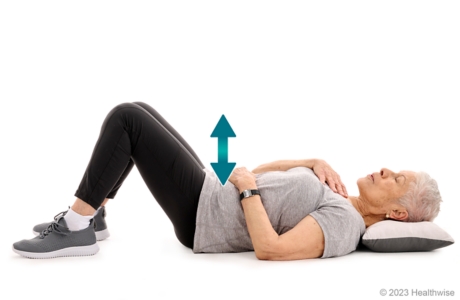
- Lie on your back. You can put a small rolled towel behind your neck or use a pillow for comfort. Or you can prop yourself up on several pillows.
- Put one hand on your belly and the other on your chest.
- Breathe in slowly through your nose. When you breathe in, push your belly out as far as possible. You should feel the hand on your belly move out, while the hand on your chest does not move.
- Breathe out slowly through your mouth. When you breathe out, you should feel the hand on your belly move in.
Practice this breathing method 3 or 4 times a day for about 10 minutes each time.
When you can do this type of breathing well while lying down, learn to do it while sitting or standing.
4-7-8 belly breathing
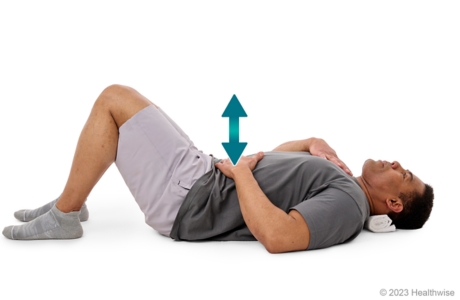
- Lie on your back or sit in a comfortable position. For comfort when lying down, you can put a pillow under your head and knees.
- Put one hand on your belly just below your ribs and the other hand on your chest.
- Take a deep, slow breath through your nose and into your belly. Silently count to 4 as you breathe in.
You should feel the hand on your belly move out, while the hand on your chest does not move.
- Hold your breath, and silently count from 1 to 7.
- Breathe out through your mouth. Breathe out completely as you silently count from 1 to 8.
Try to get all the air out of your lungs by the time you count to 8.
- Repeat these steps 3 to 5 times.
Morning breathing
Try this exercise when you first get up in the morning to relieve muscle stiffness and clear clogged breathing passages. Then use it throughout the day to relieve back tension.
- From a standing position, bend forward from the waist.
Keep your knees slightly bent, and let your arms dangle close to the floor.
- Breathe in slowly and deeply.
As you breathe in, return to a standing position by rolling up slowly, lifting your head last.
- Hold your breath for just a few seconds in this standing position.
- Breathe out slowly.
As you breathe out, return to your original position, bending forward from the waist.
Notice how you feel at the end of the exercise.
Roll breathing
When roll breathing, always breathe in through your nose and breathe out through your mouth. As you breathe out, make a whooshing sound.
Lie on your back.
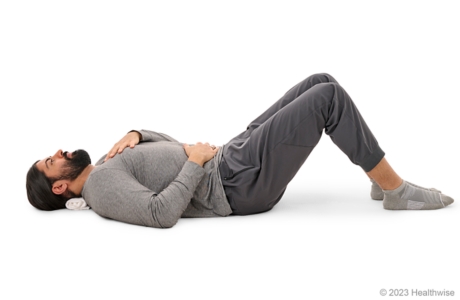
For comfort, you can place a small rolled towel under your neck. Or you can prop yourself up on several pillows. Put one hand on your belly and the other hand on your chest.
Breathe in through your nose and let the air fill your lower lungs.
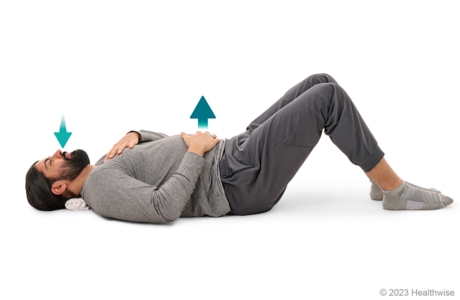
Your belly will push your hand up as you do this. The hand on your chest won't move. Then breathe out and let your belly fall.
Practice this way of breathing in and out (belly breathing) a few times before you move to the next step.
Next, breathe in as you did before, but don't stop after your belly rises.
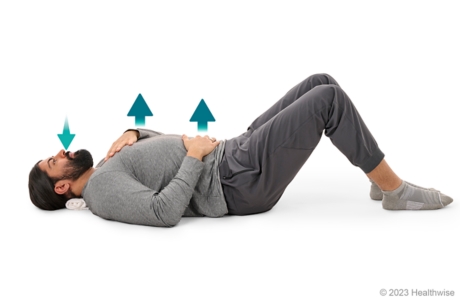
Continue to breathe in. You will feel your upper chest expand. The hand on your chest will be pushed up. The hand on your belly will fall a little as your belly starts to fall.
Breathe out slowly through your mouth, and relax.

As you breathe out, feel the tension leaving your body. Both your hands will fall.
Keep breathing in and out this way (roll breathing). Notice that the movement of your belly and chest rises and falls like the motion of rolling waves. Do roll breathing for 3 to 5 minutes.
Some people get dizzy the first few times they try roll breathing. If you begin to breathe very fast or become lightheaded, slow your breathing. Get up slowly.
Credits
Current as of: July 31, 2024
Author: Ignite Healthwise, LLC Staff
Clinical Review Board
All Ignite Healthwise, LLC education is reviewed by a team that includes physicians, nurses, advanced practitioners, registered dieticians, and other healthcare professionals.
Current as of: July 31, 2024
Author: Ignite Healthwise, LLC Staff
Clinical Review Board
All Ignite Healthwise, LLC education is reviewed by a team that includes physicians, nurses, advanced practitioners, registered dieticians, and other healthcare professionals.